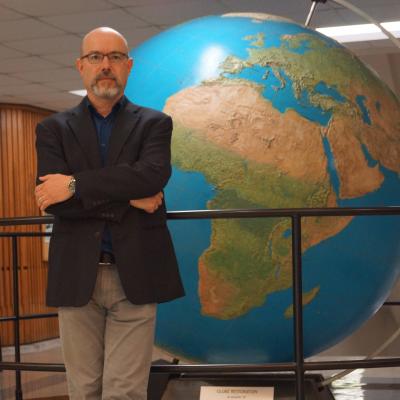
Marguerite Madden
Geography-Geology Bldg
210 Field Street,
Room 209A
Athens, Georgia
Water Quality
Mapping and Analysis of Groundwater Flow Paths, Anthropogenic Forces and Associated Environmental Impacts in Florida
The project focuses on understanding the complex interactions between groundwater dynamics, environmental conservation, and human activities in sensitive ecosystems of the Southeastern United States. It explores the impact of aquifer storage and recovery (ASR), mining, and other land-use practices on regional groundwater flow paths, water quality, and ecological health. By mapping fractures, sinkholes, and other subsurface features in karst terrains, the project identifies how these geological structures serve as preferential pathways for water movement, potentially altering hydroperiods and impacting habitats for various species, including endangered ones like the Florida panther.
Through a series of studies, the project has investigated specific environmental challenges, such as flooding exacerbated by extreme weather events like Hurricane Irma, nutrient loading from aquifer-injected effluents leading to benthic macroalgal blooms, and the declining water quality in the Greater Okefenokee Swamp Basin. These research efforts provide valuable insights into the broader implications of groundwater management and conservation strategies, highlighting the need for careful assessment of human activities that may threaten environmentally sensitive areas. Ultimately, the project aims to inform sustainable water management practices and policy decisions that protect critical habitats and maintain the ecological balance in these vulnerable regions.
Publications:
-
Bacchus, S. , Bernardes, S., & Madden, M. (2023). Implications of declining ground water and water quality in the US Southeastern Coastal Plain Ecoregion and Areawide Environmental Impact Statement required for mining in the Greater Okefenokee Swamp Basin—Part 1. Journal of Geoscience and Environment Protection, 11, 201-276 https://doi.org/10.4236/gep.2023.113014.
-
Bernardes, S., Manglass, L., Bacchus, S., & Madden, M. (2019). Analysis and extent of Santa Fe River flooding in North Florida attributed to rainfall and wind damage associated with Hurricane Irma. Journal of Geoscience and Environment Protection 7(11) https://doi.org/10.4236/gep.2019.711019.
-
Xu, W., Bernardes, S., Bacchus, S.T. & Madden, M. (2018). Management implications of aquifer fractures on ecosystem and habitat suitability for panthers in Southern Florida. Journal of Geoscience and Environment Protection 6(2) https://doi.org/10.4236/gep.2018.62012.
-
Xu, W.*, S. Bernardes, S.T. Bacchus and M. Madden (2016). Mapped fractures and sinkholes in the Coastal Plain of Florida and Georgia to infer environmental impacts from aquifer storage and recover (ASR) and supply wells in the regional karst Floridan Aquifer System, Journal of Geography and Geology, 8(2): 76-110 http://dx.doi.org/10.5539/jgg.v8n2p76
-
Bacchus, S. T., Bernardes, S., Xu, W., & Madden, M. (2015). What Georgia can learn from Aquifer Storage and Recovery (ASR). in Florida. in: McDowell, R.J., Pruitt, C.A., Bahn, R.A. (eds.), Proceedings of the 2015 Georgia Water Resources Conference. Athens, GA.
-
Bacchus, S.T., Bernardes, S., Xu, W. & Madden, M. (2015). Fractures as preferential flowpaths for aquifer storage and recovery (ASR). injections and withdrawals: implications for environmentally sensitive near-shore waters, wetlands of the Greater Everglades Basin and the regional karst aquifer system. Journal of Geography and Geology 7(2) https://doi.org/10.5539/jgg.v7n2p117.
-
Bacchus, S. T., Bernardes, S., Jordan, T. & Madden, M. (2014). Benthic macroalgal blooms as indicators of nutrient loading from aquifer-injected sewage effluent in environmentally sensitive near-shore waters associated with the South Florida Keys. Journal of Geography and Geology, 6(4) https://doi.org/10.5539/jgg.v6n4p164.
-
Bernardes, S., He, J., Bacchus, S. T., Madden, M., & Jordan, T. (2014). Mitigation banks and other conservation lands at risk from preferential groundwater flow and hydroperiod alterations by existing and proposed northeast Florida mines. Journal of Sustainable Development, 7(4), 37 https://doi.org/10.5539/jsd.v7n4p225.
-
Lines, J. P., Bernardes, S., He, J., Zhang, S., Bacchus, S. T., Madden, M., & Jordan, T. (2012). Preferential groundwater flow pathways and hydroperiod alterations indicated by georectified lineaments and sinkholes at proposed karst nuclear power plant and mine sites. Journal of Sustainable Development, 5(12), 78–116 https://doi.org/10.5539/jsd.v5n12p78
-
Bacchus, S., J. Masour, M. Madden, T. Jordan and Q. Meng (2011). Geospatial analysis of depressional wetlands near Peace River Watershed phosphate mines, Florida, Environmental & Engineering Geoscience, 17 (4): 391-415 https://doi.org/10.2113/gseegeosci.17.4.391
-
Bacchus, S., D. Archibald, G. Brook, K. Britton, B. Haines, S. Rathbun and M. Madden (2003). Near infared spectroscopy of hydroecological indicator: New tool for determining sustainable yield for Floridan Aquifer System, Hydrological Processes, 17:1785-1809 https://doi.org/10.1002/hyp.1213
